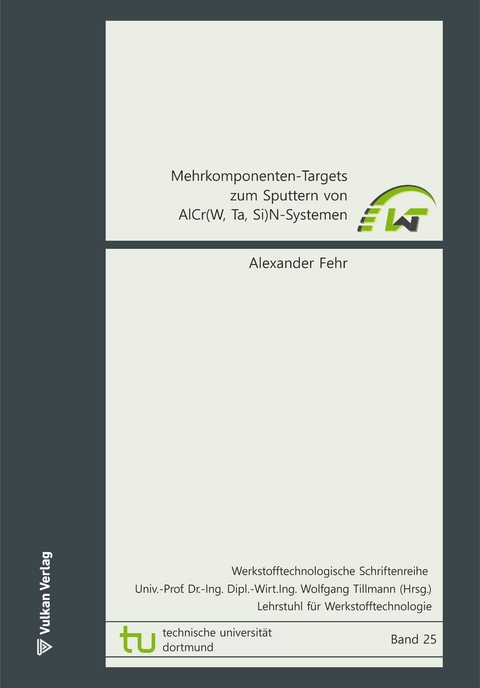Alexander Fehr, 2023
| Titel | Mehrkomponenten Targets zum Sputtern von AlCr(W, Ta, Si)N-Systemen | |
| Autor/Autor | Alexander Fehr | |
| Verleger | Vulkan Verlag GmbH | |
| Erscheinungsjahr | 2023 | |
| Gesamttitel | Werkstofftechnologische Schriftenreihe ; Band 25 | |
| Hochschulschrift | Zugl.: Dortmund, Technische Universität Dortmund, 2023 | |
| ISBN | 978-3-8027-8832-1 | |
| Sprache | Deutsch | |
| Schlagwörter | AlCrWSiN, Nanocomposite, pulvermetallurgisches Target, PVD | |
| Bezugsquelle | 31,50€ beim Vulkan-Verlag |
Abstract
In the context of PVD thin-film technology, research is increasingly being carried out for multicomponent coating systems to extend chromium-based nitrides in order to meet the increasing demands in wear protection applications. However, with an increasing number of alloying elements in the film systems, the target materials which are conventionally used in reactive cathode sputtering reach their limits. Although the chemical layer composition can easily be varied by rotating the substrates in front of individually operated target cathodes, this process results in an alternating nanolaminar layer architecture (superlattice) whose individual layers have a different composition.
In this dissertation, segmented target materials were developed using a powder metallurgical production route, consisting of mechanical milling of the powder and hot pressing, to combine all film elements in one target material. In this context, the established AlCrN film system has been expanded by tungsten, tantalum and silicon. This alloying process supported the solid solution strengthening on the one hand, and on the other hand, the formation of a nanocomposite structure, which embeds nanocrystalline nitrides in an amorphous matrix. By alloying W ≤ 6.8 At.-% and Ta ≤ 4.9 At.-% to AlCrN, the wear at high temperature (500-750 °C) was reduced by 50% compared to Al73.6Cr26.4N.

Moreover, defined stoichiometries of AlCrWSiN were generated using adapted target compositions, specific substrate temperatures, and DC, MF as well as HiPIMS power supplies.
Overstoichiometric Cr contents or equivalent (Al + W) contents to Cr in AlCrWSiN promote the formation of nanocrystalline (Cr, Al, W)N solid solutions, which are embedded in an amorphous SixNy matrix, so that a film hardness
of up to 40 GPa (Al38.5Cr47.0W5.7Si9.0N) was adjusted.
Furthermore, fundamental insights into the sputtering mechanisms on multicomponent AlCr(W, Ta)Si targets were gained. During the sputtering process, porous powder targets tend to undergo superficial phase transformations, which impair the sputtering yield of the elements.
On the other hand, defined phases at the grain boundaries and sufficient densification in the target cause an increase in the Cr film content from the target segments. Oxide phases and oxygen inclusions, which are introduced during powder processing or sintering, have a negative effect on the sputter rate and on the mechanical properties of AlCr(W, Ta)SiN. Finally, a specific sintering temperature must be selected along the powder metallurgical process route during target production in order to set defined microstructures and a reduced oxygen content in the target, which in turn is relevant for the crystallographic growth and the resulting tribo-mechanical properties of the films.



